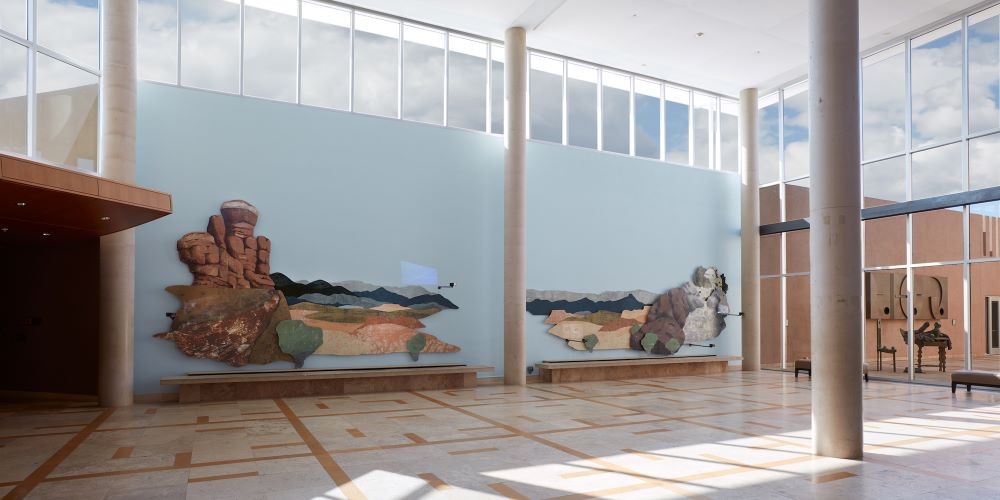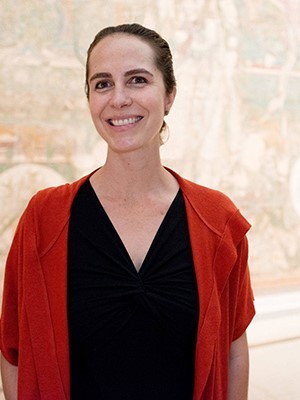This Is Who We Are: Nicola López

This Is Who We Are is a series featuring Columbia School of the Arts’ professors, covering careers, pedagogy, and art-making during a pandemic. Here, we talk with Associate Professor of Visual Arts Nicola López about her recent installation Haunted, her new course Basic Drawing: New York City as Muse, and how finished projects can seed new ones, especially in this time of isolation.
When Professor López and I speak on Zoom, she is located not in New York, but in New Mexico, where she is from. In the early days of the pandemic, López returned to New Mexico to begin work on Haunted, an installation at the Albuquerque Museum, where she is a Visiting Artist. A painting hangs beside López; it shows a dark-haired man, the canvas heavy with reds, golds, a window visible behind him in the frame. López tells me this is a portrait of her grandfather painted by his wife. Across from her, she says, there is also a drawing of her grandmother.
“I’m sitting here in my return to the roots, I guess,” López laughs. No doubt it is a sentiment shared by many who have found themselves returning to family homes during this time of uncertainty. Since March of 2020, COVID-19 has altered the ways many of us live and work, bringing unexpected challenges, and, in certain cases, unexpected advantages.

While the process wasn’t exactly as she’d envisioned it, López was still able to install her project at the Albuquerque Museum. “When I started making this project in May, we were dead center in the middle of this pandemic, and so the hopes that I had harbored for working in a print shop, for working with other people, for having access to other materials and equipment and all that, were out the window. And so I did this in a garage, basically, without a print shop around me, without all that equipment around me.”
Haunted presents an alternate encounter with New Mexico’s natural landscape. López uses printmaking and collage to capture the colors, textures, and essence of this landscape: its beauty, its remoteness. She also incorporates moving images, video projections that layer over the wall-mounted pieces. These collaged, printed, hand-drawn, and projected components combine to depict the reality of human impact, the marks we leave on earth, imprinted for the duration.
“On the surface-level, it's a sweeping, natural landscape, but the more you unpack it, the more it reveals itself as an incredibly human construction, both image composition-wise and also just material-wise,” López says. “And then the projections of these images of little moments of found human detritus that inhabit this natural world, they project them back into the landscape, so when you look closely, you realize that it's this pipe sticking out of the side of an arroyo, or it's an old abandoned car that's rusting in the river bed."
López has also had to adapt her classes to suit the new pandemic-necessitated format: Zoom. This past fall, López taught the Visual Arts senior thesis course. “I'll just be really candid,” López says, “there were some things that I thought worked really well and that I was actually very surprised by, and some aspects of the conversation, the kind of more seminar part of the class, I thought that there were ways that it was really successful.”
She continues, “And there were ways in which it's just not, there's no Zoom-substitute for seeing work in person...there's the part about not only the interaction, but the access to materials, facilities, things like that, and I worked really hard to try to make it the best possible and was also blown away by the students, and how they stepped into it and were really ready to commit one hundred percent to making it work. In no universe am I lobbying for this to be the new normal, but I think that it worked, and I also think that this connection with the students and these conversations and these interactions are more valuable now than ever, and it just kind of highlighted to me the importance of those conversations and those opportunities to share work and to talk about what we're doing and to talk about things that are really important to us as artists and human beings and a society and to be able to do that together even if we're distanced.”
This spring, López is teaching Basic Drawing: New York City as Muse. While López has taught Basic Drawing many times at Columbia in the past, this particular version will be a first. She laughs, saying that our current isolated circumstances have allowed her to spend a “ridiculous” amount of time on the syllabus.
“I've got this stack of books that I'm taking readings from, and all the images,” she says, “and it's a class that I've thought about for a long time, and now feels like the right time to be teaching this class even though it might be a little bit counterintuitive because it's going to be taught remotely, and I'm assuming that many of the students aren't going to be in New York. And before the pandemic, I had thought about doing a class that would really teach all the skills of basic drawing, all the techniques, all the conceptual approaches, that I usually introduce in a basic drawing class, but using New York City as the framework, and so thinking about it as a way to really access the city, to both learn more about drawing through the exercises that access the city, but also to explore the city and use drawing as a way to explore the world, which I think it is. But really make that manifest through the class and the syllabus, kind of put it into practice. And it's going to be a really fun class to teach when it's in person because I've got all these field trips, and we're going to go draw here, and go see that, but the more I started thinking about it for this time, the more I thought this is kind of a bizarre way to connect, but what a great way to connect with a city even if you're not there. And to think about drawing in this case as in a way a vehicle for living, as a vehicle for connecting to things and to thinking through things and forging these connections and explorations and experiences.”
Even though many museums remain closed and opportunities to show work have diminished, López uses this unusual time to think about future projects, and how former projects, including Haunted, serve as “seeds,” providing the inspiration, and sometimes even the materials, for new work. "All work, I would say, contains the seeds of future works for me,” López says, “and I think that that's something I try to nurture, and I think about often when I'm teaching as well, that it's a way also of embracing whatever experimentations one is involved in because no matter where that piece goes or what it does or doesn't accomplish, it always is doing something else in terms of starting seeds for other things and kind of making you think about other things in the future.”
“I feel like I'm gathering a lot of materials,” she says, “taking a lot of photographs that will end up in future work. This work with the video, these projections back in there, I've definitely been doing a lot of thinking around that, and also this incorporation of the landscape in a much more overt and literal way is something I've been doing more work with over these past months, in different formats, but that is something that I've continued to really build on, and that is something I'm really excited about. These little steps in our own practice feel so huge, and then from the outside you might not even notice it. But it does feel like there are some exciting steps happening, and that's good."
“I will say that this pandemic has definitely changed the shape of my studio practice,” López continues, “I haven't been in my studio in New York through this time, and so a lot of it is just physical parameters have been a lot more difficult...it's been different in every way. And then on the other kind of output end of it, a lot of museums have been closed, or really slowed down...a lot of that immediate kind of demand for output is a little bit calmed right now, which it has its moments...it's been a really good time for a lot of the groundwork, a lot of the foundation.”
López’s work in drawing, printmaking, site-specific installation, sculpture, and video explores and reshapes our contemporary, human-built landscape. It incorporates anthropology, architecture, urban planning, and historical and fictional explorations of utopia/dystopia to highlight the connections between the human-constructed world and the natural world. Her work has been exhibited across the United States and internationally, including at the Metropolitan Museum of Art, MoMA, the Guggenheim Museum, the Los Angeles County Museum of Art, the Museo Rufino Tamayo in Mexico City, the SCAD Museum of Art, the Denver Art Museum, Nevada Museum of Art, the Albuquerque Museum, and the Inside-Out Museum in Beijing. Her site-specific work Un-building Things is now on view at the Balcony Lounge at the Metropolitan Museum of Art in New York. Currently, she is finishing a four-channel, stop-motion animation video that centers on the concept of ‘Place’ as examined through representations of urban landscape. She was a Michael I. Sovern/Columbia Affiliated Fellow at the American Academy in Rome in 2020.